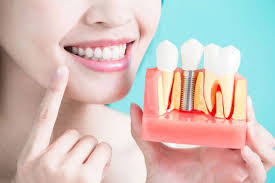A Comprehensive Guide to Dental Implants Parts
Dental implants have revolutionized the way we restore smiles and improve oral health. They are the gold standard for replacing missing teeth due to their durability, natural appearance, and functionality. But what exactly makes up a dental implant? At Maruti Dental Clinic, we believe in educating our patients about the procedures and components involved in their treatments. This blog delves into the intricate parts of dental implants, helping you better understand the process and the technology behind these innovative dental solutions.
The Key Parts of a Dental Implant
A dental implant consists of three main parts:
1. The Implant Post (Fixture)
The implant post is the foundation of the dental implant
system.
·
Material: Usually made of titanium, a
biocompatible metal, or zirconia, a ceramic alternative. Both materials are
chosen for their strength and ability to bond with the bone through a process
called osseointegration.
·
Function: It acts as the artificial root of the
tooth, providing stability and support for the entire prosthetic structure.
·
Placement: The post is surgically inserted into
the jawbone, where it fuses over a few months to ensure durability.
2. The Abutment
The abutment serves as a connector between the implant post
and the prosthetic crown.
·
Material: Made from titanium, zirconia, or
stainless steel.
·
Function: It ensures a secure connection and
transmits chewing forces to the implant post.
·
Design: Abutments can be custom-made to suit the
individual’s dental anatomy, ensuring a snug fit and natural appearance.
Types:
Stock Abutments: Pre-manufactured in standard sizes.
Custom Abutments: Designed for a perfect fit in unique
cases.
3. The Prosthetic Crown
The visible part of the dental implant, the prosthetic
crown, is custom-designed to match the size, shape, and color of the
surrounding natural teeth.
Material:
·
Porcelain or Ceramic: Preferred for their
natural look.
·
Metal Crowns: Made from gold or metal alloys for
added strength.
·
Porcelain-Fused-to-Metal (PFM): Combines
aesthetics and durability.
·
Attachment: The crown is attached to the
abutment, either by screwing it in place or using dental cement.
Additional Components of a Dental Implant
Healing Abutment
Also known as a healing cap, this temporary component is
placed on top of the implant during the healing process.
Purpose: It shapes the gum tissue around the implant site
and protects the implant from contamination.
Implant Screws
Screws secure the abutment to the implant post. These may
vary based on the design and system used.
Cover Screw
Placed over the implant post during the initial healing
phase, it prevents debris from entering the implant site.
Types of Dental Implant Systems
Dental implants can be classified based on their design and
purpose:
1. Single-Tooth Implants
Used to replace individual teeth with a single crown
attached to the implant.
2. Implant-Supported Bridges
When multiple teeth are missing, a bridge can be supported by two or more implants.
3. All-on-4 and All-on-6 Implants
These are full-arch solutions where four or six implants
support an entire row of prosthetic teeth.
4. Mini Dental Implants
Smaller and less invasive, these are used for patients with
minimal bone density.
The Role of High-Quality Materials
At Maruti Dental Clinic, we use the highest quality
materials to ensure longevity and success. Titanium and zirconia are carefully
selected for their properties, including resistance to corrosion and
biocompatibility.
Steps in the Dental Implant Process
Consultation and Examination:
·
Evaluation of oral health and bone density.
·
3D imaging for precise treatment planning.
Surgical Placement of the Implant Post:
·
Performed under local anesthesia.
·
Healing period for osseointegration.
Attachment of the Abutment:
·
Once healing is complete, the abutment is placed
to connect the post and crown.
Crown Placement:
·
The final step where the custom crown is
attached.
Advantages of Understanding Implant Parts
·
Informed Decisions: Knowing the parts helps you
choose the right system.
·
Proper Maintenance: Awareness aids in following
post-procedure care.
·
Enhanced Confidence: Understanding the process
builds trust in the treatment.
Why Choose Maruti Dental Clinic for Dental Implants?
·
Expertise in Implantology: Our experienced
dentists are skilled in advanced implant techniques.
·
State-of-the-Art Technology: We utilize
cutting-edge tools for precise placement.
·
Personalized Care: Each treatment plan is
tailored to your unique needs.
·
Comprehensive Services: From consultation to
post-implant care, we ensure a seamless experience.
Caring for Your Dental Implants
Maintaining dental implants is similar to caring for natural
teeth:
·
Brush and floss daily.
·
Use a soft-bristled toothbrush.
·
Visit the dentist regularly for check-ups and
cleanings.
Conclusion
Understanding the parts of a dental implant can make the
process less daunting and help you appreciate the intricacies involved in
restoring your smile. At Maruti Dental Clinic, we are committed to providing
exceptional care and premium dental implant solutions that cater to your needs.
If you're considering dental implants, schedule a consultation with us today to
begin your journey toward a healthier, brighter smile!
.jpg)


Comments
Post a Comment